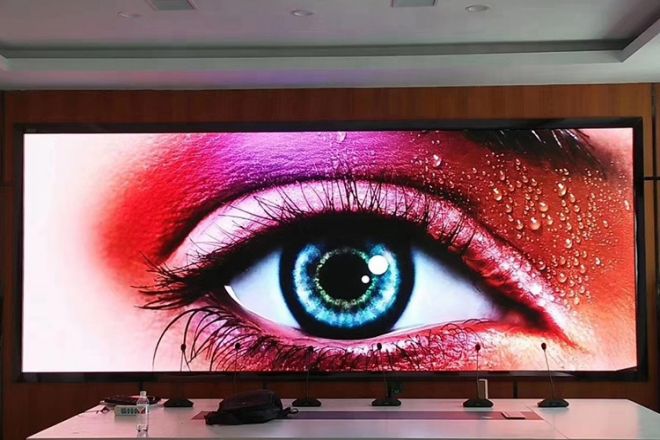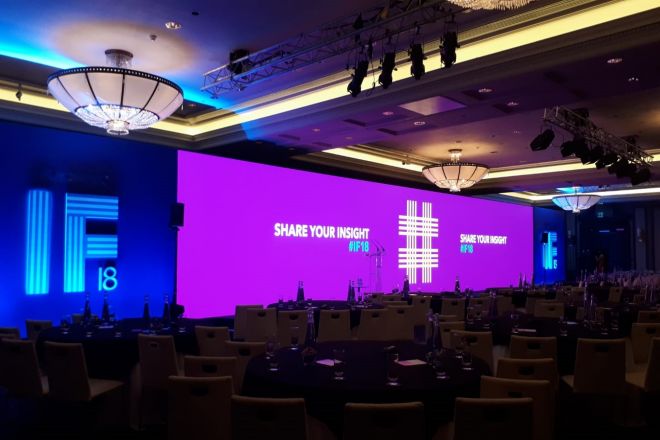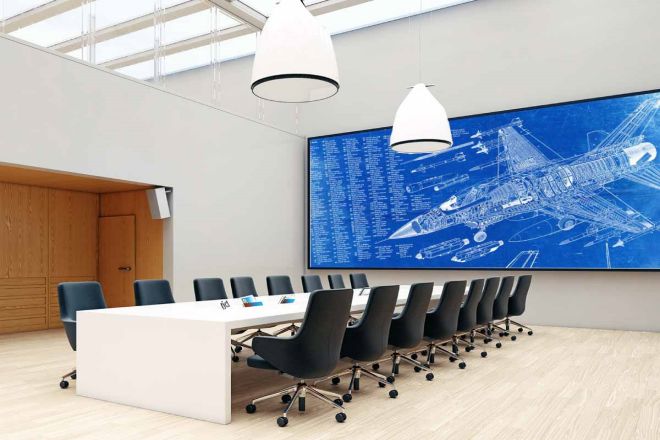Introduction

In today’s world, where digital display technology is changing with each passing day, LED (light-emitting diode) display screens are widely used in advertising, stage, conference, monitoring, and other fields with their advantages of high brightness, low power consumption, and long life.
However, for LED display screens, a key parameter indicator is the spacing between LED lamp beads, which is directly related to the display effect and viewing experience. Traditionally, we talk about the real spacing of LEDs, that is, the actual arrangement spacing of LED lamp beads at the physical level.
However, with the continuous advancement of display technology, a new concept- virtual spacing- has begun to enter people’s field of vision.
1. Definition and characteristics of LED real spacing
1). Definition of LED real spacing:
The real spacing of LED refers to the actual arrangement spacing of LED lamp beads (or LED pixels) at the physical level. Simply put, it is the distance between the center points of two adjacent LED lamp beads, usually measured in millimeters (mm).
2). Factors affecting the real spacing:
LED package size: The size of the LED package directly affects its arrangement density on the substrate, thereby determining the size of the real spacing. The smaller the package size, the more LED lamp beads can be arranged on the same size substrate in theory, thereby achieving a smaller real spacing.
Substrate design: The design layout and size of the substrate limit the arrangement of LED lamp beads. Reasonable substrate design can make full use of space and achieve a smaller true pitch.
Production process: The accuracy and stability of the production process are crucial to the control of the true pitch. High-precision production processes can ensure that the arrangement of LED lamp beads is more accurate and the true pitch is more consistent.
3). The impact of true pitch on display effect:
Pixel density: The smaller the true pitch, the more LED lamp beads per unit area, the higher the pixel density, and the stronger the ability to express details of the displayed image.
Resolution: A smaller true pitch helps to improve the resolution of the display screen, making the displayed image clearer and more delicate.
Viewing distance and visual effect: The choice of true pitch is closely related to the viewing distance. A smaller true pitch is suitable for close viewing and can present a more delicate picture, while a larger true pitch is suitable for long-distance viewing and reduces visual fatigue.
4). Adjustment and optimization of true pitch:
Select the appropriate LED package size: According to the application scenario and budget, select the appropriate LED package size to achieve the required true pitch.
Optimize substrate design: By improving the substrate design, the arrangement density of LED lamp beads can be increased to achieve a smaller true pitch.
Improve the production process level: Use advanced production processes and equipment to ensure the arrangement accuracy and consistency of LED lamp beads, thereby optimizing the real spacing.
In practical applications, the choice of real spacing needs to be weighed according to specific application scenarios and needs. Smaller real spacing can provide better display effects, but it will also increase costs and power consumption; while larger real spacing, although lower cost, may affect the display effect and viewing experience.
Therefore, when choosing an LED display, it is necessary to comprehensively consider the size of the real spacing based on actual needs and budget.
2. The concept and implementation of LED virtual spacing

1). Define LED virtual spacing:
LED virtual spacing refers to the pixel spacing presented on the display screen by technical means. This spacing is not the actual arrangement spacing of LED lamp beads at the physical level but the pixel spacing simulated from the visual effect. Virtual spacing allows us to improve the visual resolution and clarity of the picture through technical means without changing the physical spacing.
2). Implementation technology of virtual spacing:
Pixel sharing: Pixel sharing technology controls the brightness of adjacent LED lamp beads to form smaller pixels visually. For example, by controlling the brightness changes of four adjacent LED lamp beads, the effect of a pixel can be simulated, thereby reducing the virtual spacing.
Sub-pixel rendering: Sub-pixel rendering technology uses the sub-pixels (RGB colors) of each pixel in the LED display to perform more precise brightness control, thereby visually improving the resolution of the picture. Through precise control of sub-pixels, the virtual spacing can be reduced without increasing the physical pixel density.
Image interpolation: Image interpolation technology simulates higher resolution by inserting new pixel values between adjacent pixels. In LED displays, the image is interpolated through software algorithms to improve the visual quality of the picture without changing the physical real spacing.
3). The impact of virtual spacing on display effects:
The application of virtual spacing technology can significantly improve the picture quality of LED displays. By reducing the virtual spacing, we can achieve higher resolution and more delicate picture performance. This can not only improve the audience’s viewing experience but also enable LED displays to be more widely used in high-definition displays, virtual reality, and other fields.
4). Application scenarios of virtual spacing technology:
High-definition display: In the field of high-definition display, virtual spacing technology can enable LED displays to achieve high-resolution display effects while maintaining a low physical pixel density. This is especially important for large outdoor billboards, cinemas, and other places.
Virtual reality: In the field of virtual reality, virtual spacing technology can simulate more realistic scenes and more delicate texture details and improve the immersion and realism of the virtual world.
Security monitoring: In the field of security monitoring, virtual spacing technology can improve the clarity of monitoring images and help security personnel identify targets and details more accurately.
Conference room and exhibition display: In conference rooms and exhibition display venues, virtual spacing technology can provide clearer and more delicate display images and enhance the demonstration effect and the audience’s viewing experience.
3. Comparative analysis of real spacing and virtual spacing
1). Comparative analysis of advantages and disadvantages
1.1). Real spacing:
1.11). Advantages:
Solid physical foundation: The real spacing directly determines the physical properties of the LED display, such as pixel density and resolution, and has a clear physical foundation.
Intuitive and easy to understand: The real spacing is the actual spacing of the LED lamp beads, which is convenient for users to intuitively understand and calculate.
Good stability: Because it is based on physical hardware implementation, the real spacing has better stability under long-term use.
1.12). Disadvantages:
High cost: Reducing the real spacing requires smaller LED packaging and a more sophisticated substrate design, which increases production costs.
High technical difficulty: There are high requirements for the production process and precision, and the technical difficulty is relatively large.
Limited flexibility: Once the real spacing is determined, it is difficult to flexibly adjust it through software or algorithms.
1.2). Virtual spacing:
1.21). Advantages:
Low cost: No need to change the physical hardware, it can be achieved through software algorithms, which reduces costs.
High flexibility: The virtual spacing can be flexibly adjusted as needed to adapt to different display needs.
Image quality improvement: Improve the picture quality and enhance the display effect through technical means.
1.22). Disadvantages:
Depending on the physical hardware, the implementation of virtual spacing is still limited by the physical spacing and cannot be completely separated from the physical basis.
Possible visual errors: Since the pixel spacing is simulated by software algorithms, there may be visual errors or distortion.
High requirements for software algorithms: High-precision software algorithms are required to ensure the accuracy and stability of virtual spacing.
2). The trade-off between cost control, technical difficulty, and market demand
In terms of cost control, virtual spacing technology is implemented through software algorithms, which reduces production costs, while real spacing requires investment in hardware, and the cost is relatively high. In terms of technical difficulty, real spacing has high requirements for production process and precision, while virtual spacing is more dependent on the optimization and debugging of software algorithms.
In terms of market demand, with the continuous development of technologies such as high-definition display and virtual reality, the market demand for high-resolution and high-definition LED display screens continues to increase, which requires us to make a reasonable trade-off between real spacing and virtual spacing.
3). Selection strategies in different application scenarios
In the field of high-definition display: In application scenarios that require high resolution and high definition, such as cinemas, high-end conference rooms, etc., priority should be given to using smaller real spacing or combining virtual spacing technology to improve picture quality.
Outdoor billboards: Outdoor billboards are more sensitive to cost control, and viewing distance and visual effects need to be considered. In this case, a larger real spacing can be used, and the ability to express details of the picture can be improved through virtual spacing technology.
Virtual reality field: Virtual reality technology requires more realistic scenes and more delicate texture details. Therefore, in the field of virtual reality, priority should be given to using virtual spacing technology to simulate smaller pixel spacing to improve the immersion and realism of the picture.
Security monitoring: The field of security monitoring has high requirements for picture clarity and stability. In this case, appropriate real spacing can be used to ensure the stability and clarity of the picture, and virtual spacing technology can be combined to improve the ability to express details of the monitoring picture.
4. Development trend of LED real spacing and virtual spacing

1). Development trend of real spacing:
- Miniaturization:
With the advancement of LED packaging technology, the size of LED lamp beads will be further reduced, thereby promoting the miniaturization of real spacing. Miniaturization will bring higher pixel density and more delicate picture performance.
- Customization:
For different application scenarios and needs, the real spacing of LED display screens will show more customization trends. For example, in places such as high-end conference rooms and cinemas, the smaller real spacing will be used to meet the needs of high resolution and high definition, while in places such as outdoor billboards, the appropriate real spacing will be used according to factors such as viewing distance and budget.
2). Development trend of virtual spacing:
- Technical optimization:
With the advancement of software algorithms and image processing technology, virtual spacing technology will be further optimized. Through more advanced algorithms and more sophisticated image processing, virtual spacing can more accurately simulate smaller pixel spacing, thereby improving the quality of the picture.
- Intelligence:
Virtual spacing technology will be combined with artificial intelligence technology to achieve a smarter display solution. By learning and adapting to the display needs in different scenarios, virtual spacing technology can automatically adjust parameters to provide the best display effect.
3). The impact of new technologies on real pitch and virtual pitch
- Micro LED and Mini LED technologies:
These new display technologies have smaller LED package sizes and higher pixel density, which will directly promote the miniaturization of real pitch. At the same time, these technologies can also provide better display effects and lower energy consumption, bringing more possibilities to LED display technology.
- Combination of new technologies and virtual pitch:
New technologies such as Micro LED and Mini LED can be combined with virtual pitch technology to achieve more advanced display effects. For example, by combining virtual pitch technology, Micro LED displays can achieve higher resolution and more delicate picture performance while keeping the physical real pitch unchanged.
4). The driving role of market demand in the development of real pitch and virtual pitch technology
- High-definition display demand:
As consumers’ demand for high-definition displays continues to increase, the miniaturization of real pitch and the application of virtual pitch technology will become the key to meeting market demand. This will drive LED display technology towards higher resolution and more delicate picture performance.
- Diversified application scenarios:
Different application scenarios have different requirements for the real pitch and virtual pitch of LED displays. For example, in places such as outdoor billboards and large venues, a larger real pitch is required to reduce costs and meet viewing distance requirements, while in places such as high-end conference rooms and cinemas, smaller real pitch, and virtual pitch technology are required to improve picture quality.
This will promote the development of LED display technology in a more diversified and personalized direction.
Conclusion
After an in-depth discussion of LED real pitch and virtual pitch, it is not difficult to find that both play an indispensable role in LED display technology. As the physical basis of LED display, real pitch directly determines pixel density and resolution and is the cornerstone of the display effect. The virtual pitch uses technical means to present a more delicate pixel pitch on the display screen, further improving the picture quality.
Finally, if you want to know more about LED displays, please get in touch with us.
